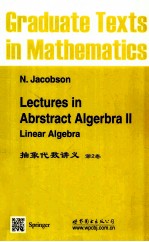

抽象代数讲义 第2卷PDF电子书下载
- 电子书积分:11 积分如何计算积分?
- 作 者:(德)雅格布斯著
- 出 版 社:北京/西安:世界图书出版公司
- 出版年份:2013
- ISBN:9787510061523
- 页数:283 页
CHAPTERⅠ:FINITE DIMENSIONAL VECTOR SPACES 3
1.Abstract vector spaces 3
2.Right vector spaces 6
3.o-modules 7
4.Linear dependence 9
5.Invariance of dimensionality 13
6.Bases and matrices 15
7.Applications to matrix theory 18
8.Rank of a set of vectors 22
9.Factor spaces 25
10.Algebra of subspaces 25
11.Independent subspaces, direct sums 28
CHAPTER Ⅱ: LINEAR TRANSFORMATIONS 31
1.Definition and examples 31
2.Compositions of linear transformations 33
3.The matrix of a linear transformation 36
4.Compositions of matrices 38
5.Change of basis.Equivalence and similarity of matrices 41
6.Rank space and null space of a linear transformation 44
7.Systems of linear equations 47
8.Linear transformations in right vector spaces 49
9.Linear functions 51
10.Duality between a finite dimensional space and its conjugate space 53
11.Transpose of a linear transformation 56
12.Matrices of the transpose 58
13.Projections 59
CHAPTER Ⅲ: THE THEORY OF A SINGLE LINEAR TRANSFORMATION 63
1.The minimum polynomial of a linear transformation 63
2.Cyclic subspaces 66
3.Existence of a vector whose order is the minimum polynomial 67
4.Cyclic linear transformations 69
5.The Φ[λ]-module determined by a linear transformation 74
6.Finitely generated o-modules, o, a principal ideal domain 76
7.Normalization of the generators of ? and of ? 78
8.Equivalence of matrices with elements in a principal ideal domain 79
9.Structure of finitely generated o-modules 85
10.Invariance theorems 88
11.Decomposition of a vector space relative to a linear trans-formation 92
12.The characteristic and minimum polynomials 98
13.Direct proof of Theorem 13 100
14.Formal properties of the trace and the characteristic poly-nomial 103
15.The ring of o-endomorphisms of a cyclic o-module 106
16.Determination of the ring of o-endomorphisms of a finitely generated o-module, o principal 108
17.The linear transformations which commute with a given lin-ear transformation 110
18.The center of the ring ? 113
CHAPTER Ⅳ: SETS OF LINEAR TRANSFORMATIONS 115
1.Invariant subspaces 115
2.Induced linear transformations 117
3.Composition series 120
4.Decomposability 122
5.Complete reducibility 124
6.Relation to the theory of operator groups and the theory of modules 126
7.Reducibility, decomposability, complete reducibility for a single linear transformation 128
8.The primary components of a space relative to a linear trans-formation 130
9.Sets of commutative linear transformations 132
CHAPTER Ⅴ: BILINEAR FORMS 137
1.Bilinear forms 137
2.Matrices of a bilinear form 138
3.Non-degenerate forms 140
4.Transpose of a linear transformation relative to a pair of bi-linear forms 142
5.Another relation between linear transformations and bilinear forms 145
6.Scalar products 147
7.Hermitian scalar products 150
8.Matrices of hermitian scalar products 152
9.Symmetric and hermitian scalar products over special divi-sion rings 154
10.Alternate scalar products 159
11.Witt’s theorem 162
12.Non-alternate skew-symmetric forms 170
CHAPTER Ⅵ: EUCLIDEAN AND UNITARY SPACES 173
1.Cartesian bases 173
2.Linear transformations and scalar products 176
3.Orthogonal complete reducibility 177
4.Symmetric, skew and orthogonal linear transformations 178
5.Canonical matrices for symmetric and skew linear transfor-mations 179
6.Commutative symmetric and skew linear transformations 182
7.Normal and orthogonal linear transformations 184
8.Semi-definite transformations 186
9.Polar factorization of an arbitrary linear transformation 188
10.Unitary geometry 190
11.Analytic functions of linear transformations 194
CHAPTER Ⅶ: PRODUCTS OF VECTOR SPACES 199
1.Product groups of vector spaces 199
2.Direct products of linear transformations 202
3.Two-sided vector spaces 204
4.The Kronecker product 208
5.Kronecker products of linear transformations and of matrices 211
6.Tensor spaces 213
7.Symmetry classes of tensors 217
8.Extension of the field of a vector space 221
9.A theorem on similarity of sets of matrices 222
10.Alternative definition of an algebra.Kronecker product of algebras 225
CHAPTER Ⅷ: THE RING OF LINEAR TRANSFORMATIONS 227
1.Simplicity of ? 227
2.Operator methods 229
3.The left ideals of ? 230
4.Right ideals 232
5.Isomorphisms of rings of linear transformations 233
CHAPTER Ⅸ: INFINITE DIMENSIONAL VECTOR SPACES 239
1.Existence of a basis 239
2.Invariance of dimensionality 240
3.Subspaces 242
4.Linear transformations and matrices 243
5.Dimensionality of the conjugate space 244
6.Finite topology for linear transformations 248
7.Total subspaces of ? 251
8.Dual spaces.Kronecker products 253
9.Two-sided ideals in the ring of linear transformations 256
10.Dense rings of linear transformations 259
11.Isomorphism theorems 264
12.Anti-automorphisms and scalar products 267
13.Schur’s lemma.A general density theorem 271
14.Irreducible algebras of linear transformations 274
Index 277
- 《习近平总书记教育重要论述讲义》本书编写组 2020
- 《线性代数简明教程》刘国庆,赵剑,石玮编著 2019
- 《高等代数 下》曹重光,生玉秋,远继霞 2019
- 《认知语言学视野的抽象方位结构研究》曹爽著 2019
- 《线性代数及应用》蒋诗泉,叶飞,钟志水 2019
- 《线性代数》孟红玲主编 2017
- 《大学数学名师辅导系列 大学数学线性代数辅导》李永乐 2018
- 《代数簇 英文版》(荷)Eduard Lo 2019
- 《抽象 推理 建模》杨明媚著 2019
- 《二十面体和5次方程的解的讲义》(德)菲利克斯·克莱因著 2019
- 《中风偏瘫 脑萎缩 痴呆 最新治疗原则与方法》孙作东著 2004
- 《水面舰艇编队作战运筹分析》谭安胜著 2009
- 《王蒙文集 新版 35 评点《红楼梦》 上》王蒙著 2020
- 《TED说话的力量 世界优秀演讲者的口才秘诀》(坦桑)阿卡什·P.卡里亚著 2019
- 《燕堂夜话》蒋忠和著 2019
- 《经久》静水边著 2019
- 《魔法销售台词》(美)埃尔默·惠勒著 2019
- 《微表情密码》(波)卡西亚·韦佐夫斯基,(波)帕特里克·韦佐夫斯基著 2019
- 《看书琐记与作文秘诀》鲁迅著 2019
- 《酒国》莫言著 2019
- 《TED说话的力量 世界优秀演讲者的口才秘诀》(坦桑)阿卡什·P.卡里亚著 2019
- 《小手画出大世界 恐龙世界》登亚编绘 2008
- 《近代世界史文献丛编 19》王强主编 2017
- 《课堂上听不到的历史传奇 世界政治军事名人 初中版》顾跃忠等编著 2015
- 《指向核心素养 北京十一学校名师教学设计 英语 七年级 上 配人教版》周志英总主编 2019
- 《365奇趣英语乐园 世界民间故事》爱思得图书国际企业 2018
- 《近代世界史文献丛编 36》王强主编 2017
- 《北京生态环境保护》《北京环境保护丛书》编委会编著 2018
- 《近代世界史文献丛编 11》王强主编 2017
- 《近代世界史文献丛编 18》王强主编 2017
